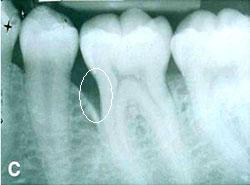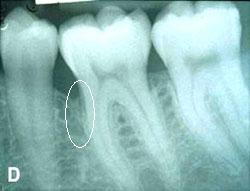450 Sutter St., Suite 1739
San Francisco, CA 94108
Call us at (415) 362-6477
Educational Articles
Periodontal regenerative procedures to save teeth
Maintaining health of teeth and their supporting structures is the goal of modern periodontics. Most periodontal practices focus on prevention of disease, initial therapy and corrective surgical treatment to eliminate "deep gum pockets". However, restoring supporting tissues to their healthy level is a critical area that offers a much more appealing, and in fact more desired outcome for our patients.
Periodontal regeneration refers to the restoration of supporting tissues of the teeth such as bone, cementum, and periodontal ligament to their original levels before damage from periodontal bacteria has occurred. The principle behind regenerative periodontal therapy is based on natural sequence of cellular activity in various living tissues. Let's consider this case scenario. An athlete injures himself while jogging, falls on the ground and breaks one of the bones in his foot. An orthopedic surgeon confirms the fracture with an x-ray and places a cast on the foot to stabilize the bone and promote healing. However, it will be at least 2-3 months before the injured athlete will be able to walk on his own. And here is another example. You accidentally cut yourself with a knife. After washing the area with water, you place a Band-Aid over the cut finger. A few days later you take the Band-Aid off, and the skin around the cut is almost completely healed. The reason that bone injury and skin injury heal differently has to do with their respective biological structures. Bone healing is a very slow process, it takes 2-3 weeks before bone starts producing new cells to fill in the injured area. On the other hand, skin or any other soft tissue starts producing new cells to repair itself 2-4 days after injury.
When periodontal (gum) disease develops, bacteria in the mouth penetrate deep below the gum line and start destroying supporting tissue of the teeth, which is bone. Destruction of the bone leads to the development of periodontal pockets, and if too much bone is lost, the teeth may need to be extracted. However, regenerative periodontal procedures could reverse some of the damage by rebuilding lost bone and other supporting tissues. During this procedure, gums are folded back and the area is thoroughly cleaned out to eliminate disease-causing bacteria. Isolation and protection of the clean bone area from overlying gum tissue will encourage body's natural ability to form new bone. Eliminating existing bacteria and regenerating bone and supporting tissues help reduce pocket depth and repair damage caused by the progression of periodontal disease.
Over the last decade different modalities of regenerative treatment have been developed and applied clinically. The positive effects of bone grafts and bone substitutes on the outcome of periodontal regenerative procedures are well documented. Most periodontists favor the use of human bone as a grafting material which has demonstrated clinical effectiveness (over 50 years of documented studies), functional periodontal repair, apparent bone defect fill, and reduction of pockets to manageable levels.
In addition to bone grafting material, the use of barrier membranes in regenerative procedures may enhance clinical success by offering better protection and containment of the bone substitute inside the defect and disallowing fast-growing gum tissue to get into the regenerative site and interfere with the process. The disadvantage of original barrier membranes was that they needed to be removed after first 6 weeks of post-surgical healing, therefore necessitating additional procedure. Introduction and improvement in clinical effectiveness of dissolving (resorbable) membranes has solved that problem. Most recommended and clinically proven to aid in regeneration membranes are collagen-based synthetic derivatives of poly-glycolic acid.
Intense research is currently underway to identify and synthesize a variety of biologic modulators that may enhance wound healing and regeneration of lost tissues in periodontal therapy. In late 1990's the material called Emdogain was introduced to the periodontal market that claimed to eliminate the need for bone grafting and use of regenerative membranes and induce bone regeneration by stimulating tissue's own growth potential. Emdogain is a proteinacious gel that contains several amelogenins (proteins that participate in enamel formation and tissue differentiation in early stages of tooth development). Unfortunately, Emdogain did not turn out to be a panacea for bone regeneration around teeth, since in most procedures it was almost impossible to contain the flowing material in the area and the overlying gum ultimately collapsed into the defect preventing any bone formation. Emdogain may be added to a bone graft to enhance wound healing during regeneration and improve periodontal attachment gain and bone fill, but has limited value if used alone.
Similarly to Emdogain, another combination material called PepGen P15 became commercially available in late 1990s. PepGen P15 consists of bovine bone and added synthesized protein P15 supposedly aiding in collagen cross-linking and therefore ensuring better bond in the early stages of regeneration of the added bone graft to the surrounding bone and root structure. Unfortunately, studies that evaluated long-term regenerative effects of using PepGen P15 were not so glamorous. The material did not integrate or "fused" with the host bone even after 1 year after surgical procedure and did not show predictable bone fill as originally thought.
The best regenerative result around teeth is usually achieved by combining a bone graft with the resorbable barrier membrane of choice.
These x-rays show pre- and post-surgical views of periodontal defects repaired with the combination of bone graft and barrier membrane.


Regeneration of supporting tooth structures is a huge step up in managing advanced periodontal disease and preventing tooth loss. Like other treatment options, it is not a panacea for all patients affected by periodontitis, but research gives us enough evidence to support the use of regenerative therapies in periodontics.
Should you have any questions or would like to discuss your case, please do not hesitate to contact Dr. Berkovich. We look forward to helping you achieve great health and a beautiful smile!
450 Sutter St., Suite 1739 - San Francisco, CA 94108 - (415) 362-6477 - coordinator@sfperiodontist.com
Sitemap • Site design by: SKEEO creative
